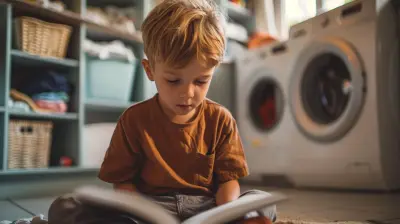How to Encourage Speech Development in Your Toddler
15 November 2025
It’s both exciting and a little nerve-wracking when your toddler starts stringing together their first words. One minute they’re babbling away, the next they’re calling out “Mama!” or “Dada!” (Cue proud parent moment). Speech development is one of those milestones that every parent watches closely. But what happens when you feel like your child isn’t talking as much as you expected? Or maybe you’re just wondering what you can do to help them talk more.
The great news is, there’s a lot you can do every single day to encourage your toddler’s speech development—and most of it fits naturally into your daily routine. So, let’s roll up our sleeves and dig into the nitty-gritty of helping your little chatterbox find their voice.
Why Speech Development Matters
Before we dive into tips and tricks, let’s take a second to understand why this stuff is so important. Speech and language development isn’t just about talking. It affects everything from how a child expresses their needs, to how they interact with the world, to how they learn at school later on.When toddlers develop strong language skills early, they’re more likely to succeed socially and academically. So if you’re wondering whether it’s worth the effort to encourage those early words… YES, absolutely!
What’s Normal? Understanding Typical Speech Milestones
Every child develops at their own pace, but there are general milestones that can help you know what to expect:- 12 months – Saying a few simple words like “mama” and “dada,” understanding common words, turning to their name.
- 18 months – Around 10-20 words, can follow simple directions, starts to mimic words.
- 2 years – Vocabulary boom! 50+ words, starting to combine two-word phrases like “more juice.”
- 3 years – More complex sentences, over 200 words, easier to understand by others.
If your child misses a milestone by a few months, don’t panic. Some kids focus on different skills at different times (like climbing bookshelves instead of talking). But if you’re concerned, don’t hesitate to check in with your pediatrician or a speech-language pathologist.
1. Talk, Talk, Talk – Narrate Your Day
If there’s one golden rule for encouraging speech, it’s this: talk to your toddler constantly.It doesn’t have to be elaborate. You’re basically narrating your life like a friendly sports commentator:
> “We’re putting on your socks. Look at those tiny toes! Now the left foot—wiggle, wiggle!”
By doing this, you’re not just exposing them to words—you’re linking language with real-life experiences. That combo is speech development gold.
Bonus Tip:
Be expressive! Use different tones and facial expressions. The more engaging you are, the more your toddler wants to pay attention (and eventually imitate).
2. Slow Down & Wait… Seriously, Just Wait
Here’s a little secret: silence is powerful. We’re often so eager to help our toddlers that we jump in too fast.Instead, try pausing after asking a question or making a comment. Give them at least 5 seconds to respond. It might feel like forever, especially if you’re used to filling every gap, but that pause creates space for your child to think and try.
> Ask: “Do you want an apple or banana?”
>
> Then wait… count in your head if you have to!
Even if they don’t answer right away, that quiet moment gives them a chance to process—an absolutely critical part of learning to talk.
3. Get Face-to-Face
When you’re talking to your toddler, drop down to their eye level. Like literally crouch down, sit on the floor, whatever works.Why? Because toddlers read your face and your mouth when they’re learning to talk. Seeing how your lips move when you say “ball” or “doggy” helps them connect sounds with shapes and meaning.
And bonus—being at their eye level makes them feel seen and heard. Eye contact + words = magic for speech growth.
4. Repeat, Repeat, Repeat
You might feel like a broken record some days—and that’s exactly what your toddler needs.Repetition helps toddlers lock in vocabulary. So if they point to a cat and say “ca,” you can respond with:
> “Yes! That’s a cat. A big, fluffy cat! Cat!”
It’s not annoying—it’s brain food. Every time you repeat a word, you reinforce it in their memory and give them another chance to try it themselves.
5. Stretch Their Speech
If your toddler says a single word, try to build on it. This is called “expanding,” and it helps grow their vocabulary and sentence structure.Let’s say your toddler says “ball.” You can say:
> “Yes, the red ball! You’re bouncing the ball.”
See what happened? You confirmed their word (so they feel successful), and then added new words to model more complex speech.
It’s like giving them ladder rungs so they can climb higher in their communication skills.
6. Sing Songs and Say Rhymes
Children’s songs and nursery rhymes are more than cute—they’re speech development superheroes.Why? Because they often have:
- Repetitive phrases
- Predictable rhythms
- Simple vocabulary
Ever notice how fast your toddler remembers the words to “Old MacDonald”? That’s because our brains are wired to remember patterns and rhyme. Use songs to introduce new words, reinforce old ones, and just have silly fun together.
7. Use Everyday Routines as Teaching Moments
You don’t need flashcards or fancy toys to teach your toddler to talk. Your best tool? Everyday routines.When you’re changing a diaper, washing hands, preparing meals—talk about it!
> “Now we’re washing hands. Wash, wash with soap. The water is warm!”
Predictable routines give toddlers context, which helps them grasp new words faster. When an experience is familiar, it’s easier for them to focus on the language around it.
8. Read Together (Even If They Chew the Books)
Reading is one of the absolute best things you can do for speech development. And the earlier you start, the better.But don’t stress about reading cover to cover. It’s totally fine if you only talk about the pictures or skip pages.
Interactive reading is where the magic happens:
- Point to pictures and name them.
- Ask questions: “What’s that?” “Where’s the dog?”
- Let your toddler turn the pages—even if it’s out of order.
The goal isn’t finishing the book; it’s sparking conversation.
9. Follow Their Lead
Pay attention to what your toddler is interested in and talk about that.If they’re obsessed with trucks, be the co-commentator on every dump truck, bulldozer, and excavator you pass.
When you focus on their interests, they’re more engaged—and more likely to try new words.
10. Limit Screen Time
This one’s tough in our digital world, but screen time doesn’t provide the same kind of interactive language learning as real-life conversation.If your toddler does watch something, try to sit with them and talk about it. Turn passive watching into active chatting.
Real human interaction is still king when it comes to speech development.
When Should You Be Concerned?
Speech delays are common, and sometimes kids just need a bit more time. But keep an eye out and trust your instincts.Here are some red flags by age two:
- Not saying at least 50 words
- Not combining two words (like “more juice”)
- Hard to understand even to familiar people
- Doesn’t point or use gestures
- Isn’t interested in interacting or communicating
Early intervention really works. If you’re concerned about your child’s speech, talk to your pediatrician. They can refer you to a speech-language pathologist.
Final Thoughts: Patience and Praise Go a Long Way
Encouraging speech development isn’t about drilling your toddler with flashcards or "teaching" them like a mini adult. It's about weaving language into your everyday life—through play, connection, and genuine interaction.Celebrate the small wins. The “mama,” the “doggy,” the first time they say “I love you”—these are massive milestones for their little brains (and your big heart).
And remember, you’re doing an amazing job just by showing up and talking to your toddler. Whether they’re speaking in single words or already forming sentences, your love and patience are the best tools you’ve got.
So, go ahead—talk their little ears off. They’re listening more than you think.
all images in this post were generated using AI tools
Category:
Parenting ToddlersAuthor:

Austin Wilcox
Discussion
rate this article
1 comments
Orion McCaw
Thank you for sharing these valuable insights on encouraging speech development in toddlers. Your practical tips and engaging activities provide a wonderful foundation for parents looking to support their child's language skills. I appreciate the emphasis on play and interaction as key components of learning.
November 15, 2025 at 4:31 AM


